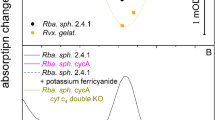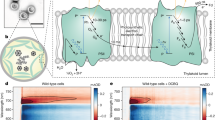Abstract
TWO sets of photochemical reactions are assumed to originate in the two chlorophyll systems II and I which together promote photosynthesis. The main point in recent discussions of the recognized partial reactions is the attribution to either of these sets or to both. Evolution of oxygen occurs only when light is absorbed by system II, and the co-operation of system I is indispensable whenever the evolution of oxygen is coupled to the reduction of carbon dioxide. To find whether excitation of system I alone can produce useful metabolites in the intact cell, experiments are required in which long wave red light, λ > 690 mµ, elicits measurable responses. In this dark red region the chlorophyll I complex absorbs far more strongly than the chlorophyll II complex. Two metabolic processes of green algae have been found which respond particularly well to selective illumination in the region between λ690 and 730 mµ; the anaerobic reactions of algae adaptable to hydrogen and the aerobic assimilation of acetate in Chlamydobotrys2,3. A third reaction of this kind is the incorporation of glucose by Chlorella induced by light under anaerobic conditions4. This reaction proceeds better in the near infra-red than in orange light at λ620 mµ. The common feature of these three metabolic reactions is that theoretically they can proceed with an adequate supply of ATP. This agrees with Tagawa's observation5,6 that chloroplast preparations in dark red light carry out cyclic photophosphorylation faster than a Hill reaction with evolution of oxygen.
This is a preview of subscription content, access via your institution
Access options
Subscribe to this journal
Receive 51 print issues and online access
$199.00 per year
only $3.90 per issue
Buy this article
- Purchase on Springer Link
- Instant access to full article PDF
Prices may be subject to local taxes which are calculated during checkout
Similar content being viewed by others
References
Bishop, N. I., and Gaffron, H., Biochem. Biophys. Res. Commun., 8, 471 (1962).
Gaffron, H., Wiessner, W., and Homann, P., in Photosynthetic Mechanisms in Green Plants, Publ. 1145, National Academy of Sciences—National Research Council, 436 (1963).
Wiessner, W., Nature, 205, 56 (1965).
Kandler, O., Z. Naturforsch., 9b, 625 (1954).
Tagawa, K., Tsujimoto, H. Y., and Arnon, D. I., Proc. U.S. Nat. Acad. Sci., 50, 544 (1963).
Tagawa, K., Tsujimoto, H. Y., and Arnon, D. I., Nature, 199, 1247 (1963).
Bishop, N. I., J. Cell. Comp. Physiol., 50, 355 (1957).
Wiessner, W., Plant Physiol., 38 (Suppl.), 28 (1963).
Wiessner, W., and Gaffron, H., Nature, 201, 725 (1964).
Kuhl, A., Vort. Gesam. Bot., Neue Folge, 1, 157 (1962).
Simonis, W., and Mechler, E., Biochem. Biophys. Res. Commun., 13, 241 (1963).
Myers, J., and French, C. S., J. Gen. Physiol., 43, 723 (1960).
Urbach, W., and Simonis, W., Biochem. Biophys. Res. Commun., 17, 39 (1964).
Author information
Authors and Affiliations
Rights and permissions
About this article
Cite this article
WIESSNER, W. Relative Quantum Yields for Anaerobic Photoassimilation of Glucose. Nature 212, 403–404 (1966). https://doi.org/10.1038/212403a0
Issue Date:
DOI: https://doi.org/10.1038/212403a0
Comments
By submitting a comment you agree to abide by our Terms and Community Guidelines. If you find something abusive or that does not comply with our terms or guidelines please flag it as inappropriate.



